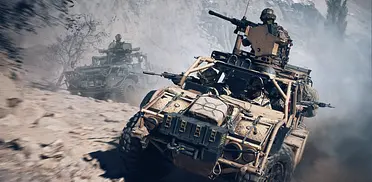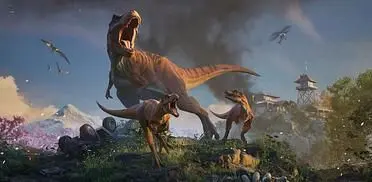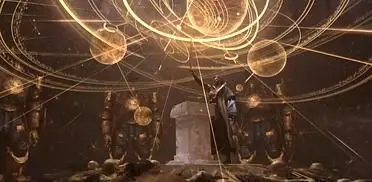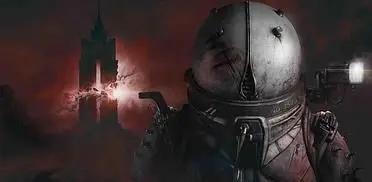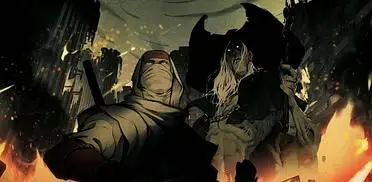The retro inspiration behind Lumo might be obvious to anyone who remembers those iconic bleeps and bloops of the Spectrum days, but for the game’s developer Gareth Noyce that’s only a small part of the entire package. Lumo takes an old school format and modernises it in numerous new and varied ways, and so we caught up with Gareth to chat about the game, his new lifestyle as an indie developer and why the games industry has lost its sense of personality…
GameWatcher: So Lumo is inspired quite heavily by classic, old school games, right?
Gareth Noyce: Yeah, I mean that isometric presentation was obviously a thing on the Spectrum and the CPC and stuff with things likes Knightlore and Head Over Heels - yeah, there were a lot of isometric games back in the day so that’s obviously the core inspiration, but with a modern take on all of those sort of old Spectrum games.
GameWatcher: How have you found modernising this old school gameplay?
Gareth Noyce: It’s fairly natural I suppose, to be honest. I’ve not tried to remake those games in any shape or form. There’s nods and there’s winks and my salute to that genre of games but I’m pretty conscious not to tread that path really. In Adventure Mode there’s no punishment for death, it’s instant respawn, you’ve got infinite lives - a lot of the old school difficulty, you know… the edges I’ve taken off. It’s not the sort of frustrating experience that there was in some of those old games. And there’s a bunch of stuff obviously that I can do with a modern computer that you couldn’t really do on the Spectrum, such as more physical things and larger rooms and smooth scrolling - it’s definitely a modern game, but sort of in the clothes of the older style of game.
 Each room is a puzzle to solve or a challenge to overcome, with over 400 rooms available in the game
Each room is a puzzle to solve or a challenge to overcome, with over 400 rooms available in the game
GameWatcher: Do you have a particular process when you’re designing a room or an idea, or is it more free form than that?
Gareth Noyce: A mixture of both really. There was a bunch of ideas and mechanics that I had on a sort of to-do list that I created right after the prototype and I had a reasonably strong idea of how the zones and stuff would work pretty early on. I sort of worked my way through the list of mechanics really, putting them into where I thought they would fit into the zones. But there was plenty of evolution stuff, too, as you go along. There’s happy accidents that you don’t necessarily think of but you put in, and then you have other ideas too. There was a kind of structure and a set of things that I wanted to do, but I tried to follow where the game has led me at the same time. I’ve tried to be pretty open and reactive to the kind of stuff I put in there. But there’s a bunch of little things that I didn’t quite get in or didn’t fit, but I think that’s just a normal part of the process really.
GameWatcher: We’ve discussed modernising the old school gameplay, but these days you can do a lot more within games than you could back then - so even with your isometric viewpoint, did you find yourself able to add something extra you might not have considered?
Gareth Noyce: I’ve not strayed massively. Essentially it’s a platformer and I tried to stick to just having one action button - there’s a toggle for the lamp but essentially it’s just a one-button game. Some of that was to try and - not emulate - but try and do that old school thing, but also it forced me to do some different solutions to the mechanics. I didn’t want to use every button on the joypad, I actually wanted to try and limit it in a sense because it was an interesting sort of design challenge. I’ve not gone massively down that path, you know there’s loads of physical interactions - it’s more that there’s simple ways to expand the core concept and if you think of the core concept as being this room exploration and mini-challenges and stuff from something - say - Head Over Heels, then Lumo expands on that in a way that obviously John Rickman and Bernie Drummond couldn’t do back in the day. But there’s bits - with it being a platformer - that you can say are inspired by Mario or those other Nintendo games - though because it’s an exploration game I was trying not to stray too close to Zelda, but you can sort of see where there are influences from other things as well.
GameWatcher: Have you found it difficult at all to keep that variety there when relying so heavily on such foundational mechanics?
Gareth Noyce: No, not in all honesty. I mean originally I kind of set the goal that I wasn’t going to reuse a mechanic more than two or three times. There are some mechanics that do get reused but they kind of get reused because they open up some mini-games and some of the stuff later on. For the 400-odd rooms that’s in there, each zone has a core set of toys that you play with and a consistent set of rules around how that works in each zone. There’s not been a lot of points where I’ve been scratching my head and I’ve been ‘what do I need to do here?’ I’ve kind of had a reasonably strong idea for each zone, and I sort of chased that down.
Obviously ‘jump’ is the core mechanic, so there’s a lot of platforming stuff in there but as it opens up and you explore I’ve played around the core concept quite a lot. There’s a lot of jumping out of rooms, there’s a lot of breaking rules that are inherent in this type of game. That’s good fun to play with, it’s stuff that not everyone will find, but I’m kind of hoping a good majority of people kind of see those bits and pieces in the game. I’ve not struggled in that sense, but I couldn’t exactly make the game twice as big - because then I’d definitely be running out of things to do.
 It’s a lovely looking game, proving that isometric viewpoints aren’t quite as restrictive - visually at least - as we’re often led to believe
It’s a lovely looking game, proving that isometric viewpoints aren’t quite as restrictive - visually at least - as we’re often led to believe
GameWatcher: There’s quite a number of Easter eggs in there too, why did you decide to make that a focus?
Gareth Noyce: It’s not really. It’s really there for two reasons. One; I wanted to make a very British game, but I also wanted to celebrate almost that cult of personality that Eighties developers and magazine reviewers and stuff had. And we’re not super referential in games, it’s not something we do a lot of unless it’s within a franchise talking about older versions. So it was nice to do something that was really kind of a salute to that kind of stuff that I loved as a kid. But the majority of it that’s in there is really stuff that makes me laugh, and I’m not expecting everyone to get all the references - there’s a lot of really subtle stuff even now that people haven’t picked up on at all, which I’m kind of happy about. It’s really there to, I guess, surprise and delight people who spot it. But it’s not the core of the game, it’s just I’ve had a lot of fun as I’ve built it and I’ve tried to make myself laugh and squeeze whatever I can in, because I can.
GameWatcher: Would you say modern games and game development has lost that sense of fun that made the early game industry so exciting to people?
Gareth Noyce: No, I wouldn’t say that. I’m pretty sure that the modern day games industry is quite exciting to young kids in the same way that it was exciting to me when I was ten years old.
GameWatcher: Maybe I’m just a cynic then…
Gareth Noyce: Well, no, it has changed, hasn’t it? We don’t have that magazine industry anymore, which was a massive part of the UK; a lot of that personality and a lot of that editorial has shifted now to YouTube and websites, and you can argue that they’re better and they’re updated more frequently, it’s just that it’s a different thing. There’s definitely more homogenisation between the games: you know you used to be able to look at a Japanese game and go ‘right, that’s Japenese’ or ‘that’s a British game, that’s American’ and rightly so triple-A games need to be a worldwide phenomenon not a kind of paroquial one. So I guess I do kind of miss what we’ve lost from that very British type of comedy Spectrum game, but it’s not been replaced by anything that is intrinsically worse - it’s just different, isn’t it?
If you chase down the triple-A thing then you’re going to get a game that you can play with anyone in the world, probably online and that’s an awesome thing. Indie developers, they’re free to chase the sorts of experiences that you wouldn’t get in that space and that gives you something else. For me, personally, when I did start having some fun with it and putting in some references and stuff in, it opened up quite a lot. I had a lot of help from Gary Penn, he was quite instrumental in putting one of the references in and he was very encouraging to sort of say ‘look, this is a good voice, it’s something we don’t do enough of’. It’s a positive thing. I understand what you’re saying, I do kind of feel that sometimes as well, but I’m pretty sure if you give a PS4 to a ten-year old their minds are going to be blown. And they’ve got loads of really cool tech in their pockets now, it’s just such a different thing, isn’t it.
GameWatcher: Have you found it much different now that you yourself are an indie developer?
Gareth Noyce: I’ve done some contracting stuff before. I’ve worked from home for a couple of projects before, so that aspect of it wasn’t a completely new thing. I’ve been motivated in the past to actually get out of bed and do something, so that kind of thing isn’t such a problem. It’s a different experience, because you can’t shout across the room and have a joke or a laugh with someone else on the team. And the game does become a lot more personal. In some ways I’m a lot more nervous about how this is going to be received or what people think about it than a lot of the other games I’ve worked on, because it has become a sort of extension of my personality and what I like. And that’s sort of scary, but it’s also good at the same time. It’s definitely a different experience, but I guess in some senses I’m still doing that same thing.
 There’s plenty of references and Easter eggs hidden throughout - some more obvious than others - which Gareth says was just his way of having fun with the game
There’s plenty of references and Easter eggs hidden throughout - some more obvious than others - which Gareth says was just his way of having fun with the game
GameWatcher: Indie development has become a huge scene these days; would you say it’s easier or harder to be an indie developer than it might have once been?
Gareth Noyce: I’m going to have to say yes and no to that. In one sense we’ve got tool chains that are basically free; you’ve got Unreal, you’ve got Unity, you’ve got GameMaker. Compared to 2005 they were just coming out. So the scope of the projects that you can do with these tools are obviously bigger and better, and that’s an absolutely positive thing. The lower we get the barriers of entry, particularly for junior developers, the better I think. It’s positive for me as well because I don’t need to write the pipelines to get assets into the build, or write the render engine - I can just get down to making the game. It’s a net win for me, as well.
The fact that you can get onto console now is obviously now a massive positive for everyone, you know, the gamers have got more games and we’ve got more places to sell our games. Stuff with mobile as well, yeah there’s a lot of competition but right now if you want to be a game developer this is probably the best time to do it because you can pick up the tools, you can go through the online tools and you can self-publish. I mean you’re not guaranteed to make money, but then no one is - and that’s the same for any kind of art that you want to do. If you’re a musician or a writer or anything, you have to work at marketing, you have to work on an audience and you have to do a bunch of things - and that’s just where we are. I think the net result is more games, more people making them, more self-expression, more places to sell those games - it’s just good.

